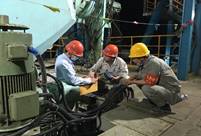Fangchenggang Steel BF1 is blown-in
Date:2020/8/19 Source: CISDI
Blast furnace 1 at Fangchenggang Steel for Liuzhou Steel has been blown in, marking another successful CISDI EPC-based reference for mega blast furnaces at coastal greenfield steel plants.
CISDI has already created mega furnaces at Baowu Group’s Zhanjiang Steel, Vietnam’s Formosa Ha Tinh Steel and Malaysia’s ASSB.

Blown-in blast furnace 1 at Fangchenggang Steel
² Master design and core tech for green, intelligent and long-campaign blast furnaces
The master design of blast furnace 1 and 2 will:
Achieve the most competitive overall economic and technical targets;
Optimise the general layout and transportation design for the ironmaking plant and individual blast furnace system;
Allocate space for installations required in the future.
Based on systematic iron, mass, energy, discharge and information flows, both blast furnaces share their stockhouse, water pump house, central control building and elevated ramp.
In this way, a large portion of the land area is saved, production capacity is ensured and production procedures are integrated smoothly.
Projected operation costs will be reduced. Allocating space for the blast furnace’s future installations, needed for technological development, will ensure the project’s systematic, cost-effective and sustainable competitiveness.

Aerial view of Fangchenggang Steel Plant under construction
CISDI has applied big data expertise, graphite blocks and lean production tech to both blast furnaces. The profile, refractory and the coolers have been optimised. Both furnaces will be operating to green, intelligent and long-campaign targets.
Green results:
Thanks to ultra-clean emissions and intensified dedusting tech, the dust concentration at furnace 1’s casthouse and stockhouse is less than 10mg/m3.
Top gas equalising and recovery tech greatly reduces gas emissions.
Soft water closed, parallel recycle tech improves the water reutilisation ratio.
Intelligent solutions:
Bringing big data expertise to traditional ironmaking production enables an intelligent production management system to operate, which enhances production efficiency.
A soft water monitoring system enables automatic exhaustion, water make-up, leakage detection and pressure stabilising functions.
Hearth’s refractory and hot load monitoring system enables a more effective temperature measurement and monitors the cooling stave’s inlet and outlet temperatures and hot loads at the hearth’s “elephant foot” area.
Long service life:
A low-shaft blast furnace design has been applied, the optimised profile for intensified smelting.
To extend the one-generation campaign life, a number of core tech inventions are playing crucial roles:
Cooling staves with a large specific surface area at the furnace’s bosh and belly
Optimised refractory structure and thicker refractory installed at hearth’s critical positions
Graphite blocks featuring a high thermal conductivity added between cooling stave and carbon block for greater safety protection.
² Advanced management and digital design - boosting efficiency and quality
CISDI’s turnkey services met the challenges posed by huge quantities of work, complicated interfaces and natural conditions, plus the Covid-19 pandemic.
An internationally-aligned, advanced project management and full-process control system operated throughout the project (data, spreadsheet and information technology-based).
CISDI led multi-disciplinary design and management teams, two construction companies and more than 90 sub-suppliers during the 19-month construction period.
Digital design contributed greatly to efficiency and quality:
BIM tech to the furnace proper’s design resulted in higher construction quality and implementation efficiency;
Digital design of the cooling stave shortened the furnace proper system’s design time; without this process the construction schedule could not have been ensured, as staves should have been the earliest equipment to arrive and be installed. They are the largest portion of the project and require a large amount of work onsite.
Digital design enabled critical data – the height, thickness, calibre, angle and bill of materials - to be highly accurate under the standardised and modularised design environment, which improved equipment quality.

The centralised control room for blast furnaces at Fangchenggang Steel Plant
Experienced in building coastal steel plants, CISDI initially carried out a HAZOP (hazard and operability) study on the process, equipment and facilities.
It embodies an intrinsic safety principle that essentially strengthens the blast furnace’s capability for resisting coastal acid corrosion, typhoon and storm damage and soft foundations.
² Meeting the challenges
Constructing both blast furnaces simultaneously at Fangchenggang Steel meant double the difficulties. The construction team was faced with huge quantities of work, complicated interfaces, an unfavourable climate and the situation caused by the Covid-19 pandemic.
To ensure design, equipment control, construction, safety and quality control for both furnaces went smoothly, the team organised online meetings with Fangchenggang and the builder and resumed onsite work with ensured safety 10 days ahead of the customer’s schedule.
The team met each milestone on time – assembly of the automation system, stove heat-up, combined commissioning and BF pressure test.

Teams from CISDI and Fangchenggang work on BF1’s casthouse

